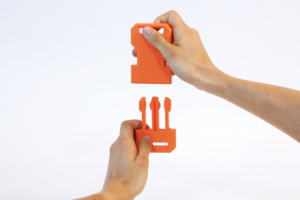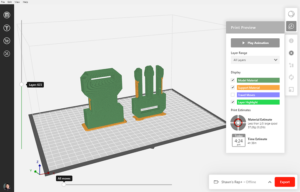MakerBot Relaunches Tough PLA 3D Printer Filament, with Additional Material Properties Data, in Three New Colors
 In the fall of 2016, MakerBot introduced its Tough PLA filament for the first time. This strong, plastic material, which I heard about again more recently at MakerBot’s RAPID 2018 booth, mimicked many of the mechanical properties of ABS, but with the reliability and high quality one can expect from PLA. The company has now relaunched its custom IMPLA material, with three additional colors and new material properties data.
In the fall of 2016, MakerBot introduced its Tough PLA filament for the first time. This strong, plastic material, which I heard about again more recently at MakerBot’s RAPID 2018 booth, mimicked many of the mechanical properties of ABS, but with the reliability and high quality one can expect from PLA. The company has now relaunched its custom IMPLA material, with three additional colors and new material properties data.
First off, the resilient MakerBot Tough is well-suited for desktop 3D printers in the office, which helps dramatically impact the overall design cycle. This durable filament was designed to offer the same tensile and flexural strength as ABS, with twice the impact strength, but far less curling and warping…without having to use a heated build plate or chamber. With MakerBot Tough, rest assured that you’re 3D printing functional prototypes, parts, and manufacturing aids that can hold up well under all kinds of stress.
According to a MakerBot post, “By combining easy access to rapid prototyping with advanced materials, designers and engineers can test more applications sooner and build functional prototypes that disrupt typical outsourcing.”
 The same properties that make MakerBot Tough so durable also make it highly machinable for many post-processing techniques; additionally, the filament allows developers to test multiple mechanical applications and features, from impact-resistant assemblies and high tension clips and springs to tapping and threading.
The same properties that make MakerBot Tough so durable also make it highly machinable for many post-processing techniques; additionally, the filament allows developers to test multiple mechanical applications and features, from impact-resistant assemblies and high tension clips and springs to tapping and threading.
With a flexural modulus of 343,000 psi, a melting temperature of 302-320°F, and tensile strength measuring 5,710 psi, MakerBot Tough ensures certified reliability with a custom tuned profile in MakerBot Print.
The company’s industrial design team put the material properties of the newly relaunched MakerBot Tough through their paces, and built a few highly functional objects to properly test out the filament. The first of these was a prototype of a mountain bike shock absorber, which, according to MakerBot, “simulates variable tension using durable threads along a stem that lengthens or shortens the spring.”
These types of assembly prototypes are helpful when it comes to early fit and mechanical studies, and MakerBot Tough even gives it a little extra functionality that would not be easy to test otherwise. Additionally, the spring takes advantage of the filament’s elasticity, which also helps extend the lifetime of durable threads along the stem of the product.
MakerBot also 3D printed and tested out an Omni Wheel, a poly-wheel system popular in the robotics field for making lateral movement and many different axis rotations and unconstrained moves possible.
“Whereas typical prototyping would require the wheel hub and teeth to be machined before testing assembly fit and mechanics, the MakerBot Tough prototype simulates the final wheel well enough to enable more testing and better revisions before committing to final drawings,” the MakerBot post reads. “It features high elasticity and deformation that enabled our designers to embed the main ball bearing with press fitting, impact resistant teeth for repeating testing, and lubricious contacts for easy assembly and smooth rolling.”
The final product was a side-release buckle, which is used in applications ranging from industrial securing equipment to consumer backpacks – my husband likes to go hiking, and I’ve seen several of these kinds of buckles on his gear. In order to work properly, this part needs resilient, high tension prongs that are able to snap right into place, but with the right amount of elasticity – just like with the shock absorber – so they won’t lose shape or tension when returning to their original position.
When typical PLA is used to make these kinds of prototypes, designers also have to make changes, like the thickness of the prong, to get past the constraints of the material. But MakerBot Tough actually simulates the injection molded plastics of the final product, without having to change any of its main mechanics.
“One important tip for printing high tension objects in MakerBot Tough: focus on testing wall thickness (number of shells) instead of infill,” MakerBot writes. “For the most part, 10-20% infill will be successful, but won’t have as big an impact on stiffness as the number of shells will—and in general the higher each value is, the higher the tension will be.”
MakerBot Tough filament is now available in four colors: Slate Gray, Safety Orange, Stone White, and Onyx Black.
Discuss materials and other 3D printing topics at 3DPrintBoard.com or share your thoughts below.
[Images provided by MakerBot]
Subscribe to Our Email Newsletter
Stay up-to-date on all the latest news from the 3D printing industry and receive information and offers from third party vendors.
Print Services
You May Also Like
New Business: Temporary, Migratory, & Modular 3D Printed Architecture
If we look at potentially emerging 3D printing businesses, then architecture has not been fully explored. Yes, there is a lot of house 3D printing going on worldwide. From deployable...
3D Printing News Briefs, April 19, 2025: Material Extrusion Standard, Metal Powder, & More
In today’s 3D Printing News Briefs, we’re covering a proposed standard for material extrusion, before moving on to business and metal powder. We’ll end with a commercial store’s robotic 3D...
Japan Unveils World’s First 3D Printed Train Station
Japan is now home to what we believe is the world’s first train station built with 3D printing technology. Located in Arida City, just south of Osaka, the new Hatsushima...
restor3d Raises $38M to Expand 3D Printed Orthopedic Implants
Backed by $38 million in new funding, restor3d is pushing ahead with the launch of four personalized implant lines, set to roll out in 2025 and 2026. This latest venture...






























